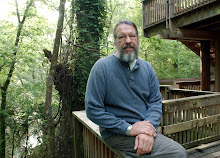rainmaker, rainmaker
the sky is gray, the ground is so hard
it's been cracked by the sun
rainmaker, you know my work's never done
– Steve Winwood/Jim Capaldi
I guess the wheels really started turning on the morning of Tuesday, March 29 when I heard Traffic's “Rainmaker” spun on the local public radio station (KRVS...give it a listen...it streams on the www; and check out Traffic's music on youtube or wherever while you're at it...they're awfully good...) by master musicologist/producer/disc jockey Cecil Doyle. We hadn't had a decent rain here for nearly a month. The local plants and animals were begging for it. Pollen had saturated the air so thickly that it was coating cars/windshields/houses/sinuses on a daily basis.
Most people give but little notice to such things; but farmers, gardeners, outdoorsmen, nature-watchers, and others whose livelihoods are directly affected by too much or too little rain are acutely aware of them.
“Rainmaker” became my prayer that Tuesday morning. God, please make us some rain. Many of our plants had no sooner put on leaves and already they were flagging for lack of moisture. That morning the first of “our” Prothonotary Warblers had shown up at the house. He flew right up to the deck, sat on top of the old camelia there, and sang out his joy. Directly, he flew down into the coulee to check out his brown-painted-inverted-plastic-water-bottle house I had set on a pole some years ago. Then he flew into his old drinking/bathing dish that Lydia sets out on the porch rail for him and the chickadees. Oops. Dry as bone. Hmm.
By Tuesday afternoon the forecasted “scattered thunderstorms” fired up to our north. We received no more than a spit, barely coating the leaves of the local plants. Even so, it was enough for the Prothonotary to bathe in. Even before the drizzle had stopped, he had positioned himself directly beneath a big camelia leaf, half-fluttering his wings in an effort to spread the meager moisture at the sides of the leaf over as much of himself as possible.
By evening we hadn't received any more rain. It looked to be yet another “near-miss” Pacific frontal passage. We've had a lot of them lately. By 11:00pm, storms had again fired up to our north, lighting the sky with constant flashes, but nary a drop of rain on us. Bummer, man.
Then suddenly, 'round midnight, here it came. We finally got a good soaking – over an inch anyway. Yes! We'll take it. Thanks be to the Rainmaker.
The next morning I eagerly hit the back porch to see how the local plants and birds made out. The first thing that I noticed was that all of the newly-emerging leaves of the local trees and shrubs, which previously had been sort of eeking their way out of bud – as if they dreaded emerging into the dryness – had suddenly expanded by a factor of two or maybe even three. Despite a rather chilly north-northeasterly breeze, the Prothonotary was streaking up and down the coulee like a black-lab puppy, singing his lungs out. Overhead, four or five cardinals were leaf-bathing amongst the feathery, newly-emerged, water-coated leaves of a big bald cypress.
Then I heard a song that I'd never heard before – or at least had never noted before – a long, complex, mechanical trill, somewhat like that of the Winter Wren. Suddenly, the singer plopped up into the Oriental buttonbush ten feet away and right in front of me. With his back turned to me, he launched into two or three rounds of his awesome song.
Chipping Sparrow
photo by Russ Norwood http://www.perceptivist.com/
Wow. Not a wren, but a sparrow. A sparrow with fairly bright-rufous wings and a plain gray band below the nape of his neck. I had to see his face and breast. Borrowing from John “The Bird-whisperer” Conover's arsenal of bird-studying tricks, between pursed lips, I made two very muted, very tiny squeaking noises in quick succession, otherwise remaining motionless. The singer immediately turned to face me and fearlessly launched into another couple of rounds of song. Whoa. Clear, dull-gray breast and dark-brown crown, parted down the middle by a pale brown-gray line. A Chipping Sparrow, half-molted into breeding plumage.
Once the sparrow departed to the big American hornbeam on the other side of the barn, I decided to follow him. I wanted to hear more. But as I approached the barn, I became distracted by the mighty bloom show put on by a wild hawthorn and a native florida-flame-type azalea that Lydia had planted many years ago. Whoa! What a difference a rain makes! Yesterday, both were still in tight bud.
left, Mystery Haw
right, Tommy Dodd's hybrid Florida Flame Azalea
detail: Tommy's Azalea
Mystery Haw
That hawthorn presents a real mystery to me. Typically, the only wild hawthorn native to the bottomland forests of this latitude is the green hawthorn (Crataegus viridis; aka “hog haw”), but this particular tree, present since we moved here in 1982, has larger leaves and longer thorns than the green haw. Nearest I can tell, it might be a cock's-spur hawthorn (C. crus-galli) or perhaps a hybrid between green and cock's-spur. Regardless, it's a beaut.
native Swamp Privet (Forestiera acuminata)
Swamp Privet flower detail
Heading back to the house, I noted one more rain-induced fancy-bloomer, the swamp privet (Forestiera acuminata). Not an invasive-exotic privet, the swamp privet is native to our region, but lives mostly tucked away in swamps and in very wet bottomland hardwood forests.
Water's the drink which stirs the plants which stir the animals...even the humans.










No comments:
Post a Comment